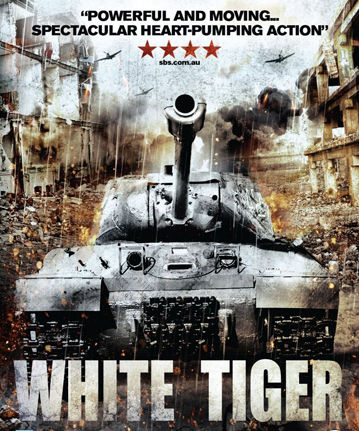
Every war produces myths and legends, and WWII is no exception. The 2012 film White Tiger examines just such a wartime legend. This is a Russian action film directed by Karen Shakhnazarov. The film was selected as the Russian entry for the Best Foreign Language Oscar at the 85th Academy Awards, but it did not make the final shortlist. It is based on the novella Tankist, ili “Belyy tigr” (The Tankman, or “the White Tiger”) by Russian writer Ilya Boyashov.
The film opens with Soviet infantry advancing without opposition across the remnants of a grim battlefield. As other soldiers work to clear the debris of war, both human and material, they find a sergeant still gripping the controls of his tank, and burned over 90 percent of his body, yet still alive. Three weeks later, when the bandages are removed, he is discovered to have made a miraculous recovery, and that is only the first mystery that confronts and confounds the Red Army officers who come in contact with this peculiar combatant.
The soldier was wounded in an attack by a Nazi armored vehicle known at the front as “the white tiger.” At first it would appear to be a fairly typical tiger tank, a fearsome enough weapon of war on its own. But this one seems indestructible, inflicting heavy losses before disappearing almost into thin air and traversing what would appear to be impassable terrain, only to once again appear behind the lines and surprise the Soviet forces.
To solve this mystery, the Soviets question every German prisoner of war they can get their hands on, but they prove to be just as confused, and provide just as conflicting reports, as their own comrades give. The theories include a ghost vehicle, a tank manned by a crew of zombies, or a tank that requires no crew at all.
The command dismisses the more mystical notions and determines that the tank must be a one-of-a-kind manufacture, specially fitted with a high horsepower engine and heavy armor. The Soviets then set out to create a super tank of their own and staff it with an exceptional crew, which will include the aforementioned survivor of a white tiger attack.
Actor Vitaliy Kishchenko is excellent as a strong and determined major of the Soviet counterintelligence corps who has been tasked with the mission to destroy the white tiger, while at the same time keeping an eye on the spooky tankman. Kishchenko fills out the character nicely, carrying a captured German MP-40 submachine gun as his personal weapon throughout the film, and demonstrating the personality of a man with steady nerves and considerable combat experience.
As the story unfolds, the major begins to go against his own sound instincts, finding something compelling about the curious tankman who, when battles are over, communes with the burned-out hulks of once mighty armor and, like a forensic pathologist, determines how and why the destroyed tanks died in battle. Another good character is a captain who provides the counterbalance, stoutly believing that the tankman has simply gone off his head in the heat of battle, and who slightly riles the major with his cynicism.
The heroism of the Soviet people in response to fascist aggression is undeniable and well documented. As to the reality and fate of the fabled “white tiger,” for that you will have to see the movie.
White Tiger
Director: Karen Shakhnazarov
Writers: Aleksandr Borodyanskiy and Karen Shakhnazarov (screenplay), Ilya Boyashov (novel),
Actors: Aleksey Vertkov, Vitaliy Kishchenko, Valeriy Grishko
Unrated, 103 minutes, region 1 DVDs are apparently dubbed from Russian into English.






